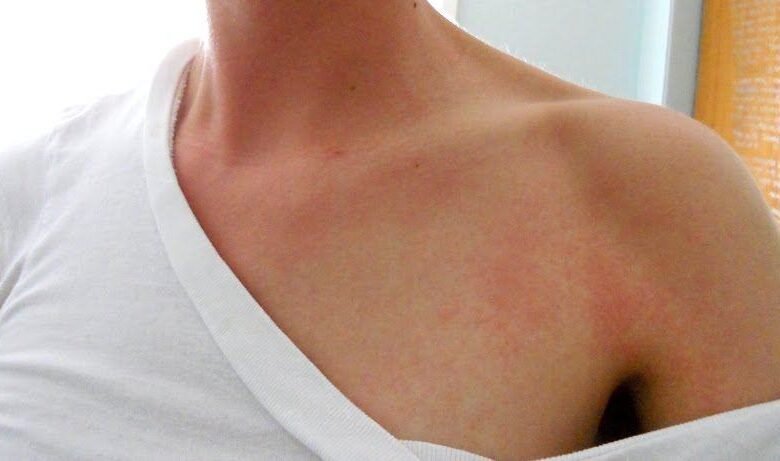Heat rash

What is heat rash?
Heat rash is a general term for a number of skin problems that occur or worsen due to exposure to heat or overheating.
Although most common in infants, it can occur in people of all ages.
Heat rash most often occurs in the summer months and especially in humid weather.
The condition usually resolves quickly after about a few hours to a few days without treatment. Rarely, heat rash can get so bad that professional help is needed.
What are the symptoms of heat rash?
Symptoms of this type of rash can vary, usually appearing as small, slightly swollen dots around the areas where the hairs pierce the skin.
Red or pink spots on the skin may also be seen.
Due to different skin reactions, some people may experience severe burning and itching, while others may not experience any irritating symptoms.
It is important to note that any part of the body can be affected by heat rash.
Therefore, it is important to know the areas most prone to this type of rash in order to take appropriate precautions. Rashes usually appear in the following areas:
-
Face, neck and neck: Heat rashes can appear around the ears, on the neck area and on the back of the neck due to heat being trapped around these parts of the body. the body.
-
Abdomen, groin, and under the folds of the breasts: Heat rash is common on the upper abdomen, around the groin, and in the area under the breasts, as these areas are prone to to retain more heat and moisture.
-
Knee creases and buttocks: These areas of the body are also susceptible to heat rash, especially if the skin is exposed to multiple contact points that trap heat and moisture .
What are the causes?
Heat rash is basically related to the functioning of sweat glands and hair follicles.
The process of sweating is a normal body function that helps it maintain an optimal temperature by evaporating sweat from the surface of the skin.
However, when this process is disrupted, the ducts of sweat glands and hair follicles can become blocked, preventing sweat from evaporating normally.
This can cause sweat and moisture to be trapped near the skin, creating the right conditions for heat rash to develop.
Human sweat contains a high concentration of salts and other chemicals that make it a strong irritant to the skin.
When this sweat becomes trapped near the surface of the skin, itching, burning, and irritation can occur, creating the symptoms characteristic of heat rash.
The skin is a sensitive organ, reacting to various stimuli, and blockage of the channels can cause unpleasant reactions.
How is heat rash treated?
The best way to prevent heat rash is to avoid sweating by staying in cooler areas with fans or avoiding strenuous exercise.
Here are some ways to help yourself with heat rash:
- First – wash the affected area with a mild soap such as Dove, then rinse the area thoroughly with water and dry gently with a towel. It is recommended to wash several times a day and necessarily after exercise, prolonged walking or exposure to heat.
- Stay cool and leave the area of the heat rash exposed so that it can cool. .
- Take a shower with lukewarm water or a bath with lukewarm water, the water temperature should be around 15-18 degrees.
- Rest in an acclimatized a room with a temperature of about 20-22 degrees is very helpful.
- Ice the affected areas, but for no more than 20 minutes.
- Mild cortisone creams such as hydrocortisone or stronger prescription cortisone creams such as triamcinolone are helpful for persistent rashes or if they are triggered by eczema.
- Oral antihistamines such as diphenhydramine or loratadine can reduce itching.
- Wearing light, cotton and absorbent material will relieve skin irritation.
- Drink plenty of water for overall hydration and body temperature regulation. Water helps maintain a lower body temperature.
How to protect yourself from heat rash?
- Clothes that should be made of light breathable materials.
- Avoid wearing polyester and nylon clothing.
- Maintain a comfortable temperature in the rooms where you spend most of your time.
- Babies and toddlers should be kept dry and their diapers changed often and not covered especially in the summer months, but to put on light and breathable clothes.
- Do not apply ointments, vaseline or heavy make-up to the skin.
- Do not stay in very hot and humid places for a long time.
- Keep your skin clean by washing your skin with a mild soap after sweating or heavy physical activity.
In order to achieve optimal skin health and prevent heat rash, it is important to maintain regular hygiene using appropriate skin cleansing and nourishing products.
Combining this care with consideration of the climate and using clothing that allows the skin to “breathe” can go a long way in preventing this irritating skin problem.



